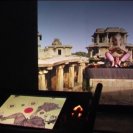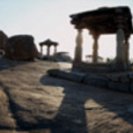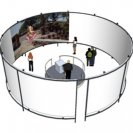Place-Hampi is a vibrant theatre for embodied participation in the drama of Hindu mythology set into a real-world landscape. PLACE-Hampi provides the setting for a stereographic virtual landscape, populated by sixteen cylinders enclosing a constellation of cinematic events in which the audience can participate, traverse and examine at will.
It is a modular interactive cinema where three kinds of narrative spaces are conjoined: The cylinders comprise augmented high resolution stereoscopic panoramas that present the most significant archaeological, historical, and sacred locations at the site of the World Heritage of Vijayanagar in Hampi, southern India. Conjoined within this rich scenery are lively narrative events, enacted by computer graphic characters, based on the mythologies specific to the site that have been composited into the three dimensional landscapes. The scripted narrative animations are latent events that come to life when the operator of the interface focuses attention on particular features within the panoramic scene.
In addition, the visual landscape is contained within a spatial aural field (the third space) made from decoded ambisonic 360 degree recordings, enlivened by composition brought about by the audience’s activities and played back in real-time. This real-time interactive rendering and delivery system will use sophisticated mapping and transformation strategies as the user controls and navigates the space, to deliver a sonic experience, which is intimately and deeply connected with the visually presented and augmented space. This articulates an unprecedented level of viewer co-presence in the narrative exploration of a virtual cultural landscape.
The panoramic cylinders are accurately positioned on the data terrain model (DEM) that overlays a diagram of the sharira-mandala used for the placement of buildings at Hampi, through which the operator makes a journey. The user-interface’s screen shows a bird’s-eye view of this virtual environment, centred on the viewer’s changing location. A microphone incorporated into this interface picks up any sound that the viewer makes and causes the release of continuously moving 3D words and sentences within the projected scene (English and Sanskrit initially). The texts themselves are quotations from the Hindu ascetic Alvars to provide a further level of narrative articulation to the animated events that are located within each of the panoramas.
Place-Hampi provides a framework for a new approach to the rendering of the cultural experience, whose aesthetic and representational features gives the general public a dramatic new appreciation of the many layered significations of such historical, archaeological, and architectural spaces. While PLACE-Hampi embodies a single user interaction model, the autonomous narrative scenarios that populate each of the panoramic scenes with mythological significance become endowed with the emergent narrative relations that are generated by each viewer’s interactive exploration of this virtual environment which are also available to the total audience simultaneously present (maximum 30 people). The work, as defined above, is considered at the forefront of international developments of virtual environments and the complex arrangement of technical and aesthetic parameters that are required to develop them.
Place-Hampi is highly significant for promoting dialogues of engagement embedded in the imagery of a cultural landscape and activating the knowledge contained there. Hampi today continues to be an active pilgrim site, not simply an historic place. Each day its landscape and temples are activated through various rituals and tapas specific to time, place and to discrete locations in the complex. As part of a living tradition, the interpretation of the site by pilgrims is in a constant state of re-definition within the broad tenants of Hinduism. A conversation takes place between mythological characters and the sacred objects/sites/natural features permeated with the contemporary “folkloric imagination” of the pilgrims.
Hindi priests and pilgrims are not the only ones to enliven these Hindu images and temples. Bringing with them different religious assumptions, political agendas and economic motivations, others may animate the same objects or sovereignty as polytheistic “idols”, as “devils” as potentially lucrative commodities, as objects of sculptural art, as archaeological and historical relics, or attribute to them meanings and associations never foreseen by the image maker or votary. As Davies points out “the location of an object plays a constitutive role in the act of looking” in addition to this appropriation, relocation and redisplay of an object will dramatically alter its significance for new audiences. The frame of reference or dispensation designates the historically grounded and socially shared understandings of systems. Place-Hampi reconstitutes the landscape for these interpretations of mythological narratives in the form of co-presence, enabling a new mode of interpretation accessible for diverse cultural audiences.










